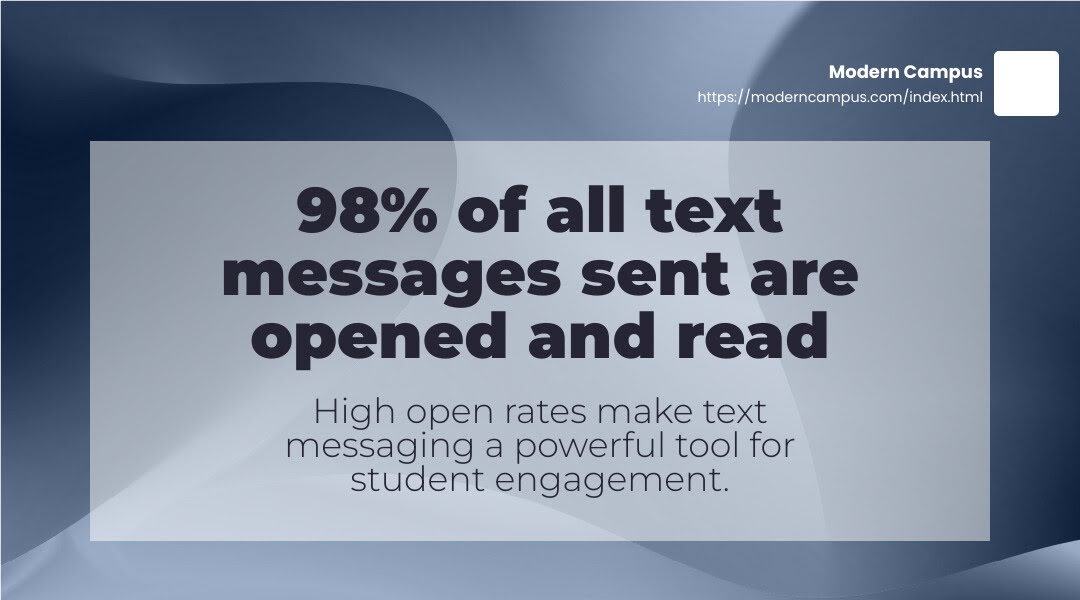Tips for Organizing Your University Course Catalog
Organizing a university course catalog is a critical task that ensures students can easily access and navigate available courses. It’s what helps them make informed decisions about their academic paths. A well-structured catalog not only categorizes courses by departments and programs but also provides detailed descriptions, prerequisites and scheduling information.
Incorporating an SMS platform into this process can greatly enhance the efficiency of communication between the institution and its students. SMS platforms allow universities to send timely reminders about registration deadlines, waitlist openings or new course offerings directly to students' phones. This real-time communication helps students stay informed and take immediate action, improving the overall course selection experience.
Organizing your university course catalog effectively ensures students can easily navigate their options and select the courses that best fit their academic goals. Here are some tips to streamline the process while incorporating modern tools, like a higher education texting platform, to enhance communication with students.
Categorize by Department and Degree Program
Organizing your university course catalog by department and degree program is essential for effective curriculum management. This method allows students to easily navigate their academic paths and locate the courses they need.
Department Organization
Begin by grouping courses under their respective departments. This enables students to quickly identify which department offers the courses they are interested in. For instance, all courses related to Computer Science should be under the Computer Science Department. This categorization enhances clarity and helps maintain a structured catalog.
Degree Programs
Within each department, list courses according to degree programs. Whether it’s a certification, Bachelor’s, Master’s or PhD program, having a clear distinction helps students understand the requirements and electives available for their specific program. This organization effectively supports students in planning their academic journey.
Curriculum Management
Effective curriculum management involves more than just listing courses. It requires regularly updating course offerings and ensuring that prerequisites and course sequences are clear. This is where a higher education texting platform can be a valuable tool. By integrating SMS notifications, universities can keep students informed and engaged by alerting them about changes in course availability or prerequisites.
Efficient organization of the course catalog enhances the student experience and streamlines administrative processes. By categorizing courses by department and degree program, universities can create a user-friendly catalog that supports student success.

Search and Filter Options
Students expect quick and easy access to information. To meet these expectations, a well-organized university course catalog should include robust search and filter options.
Search Functionality
A powerful search tool is essential. Students should be able to type in keywords and quickly find relevant courses. This feature saves time and reduces frustration, especially when students are unsure of the exact course title or code.
Imagine a student interested in environmental science. With effective search functionality, they can type "environment" and instantly see all related courses–from introductory classes to specialized electives.
Filter Options
Filters improve the search experience by allowing students to narrow down results based on specific criteria. Useful filters might include:
- Course Level: Undergraduate, graduate or doctoral.
- Credits: Number of credit hours.
- Schedule: Morning, afternoon, evening or online.
- Instructor: Search by professor or teaching assistant.
These filters help students quickly find courses that fit their academic needs and personal schedules.
User-Friendly Interface
A user-friendly interface makes it easy for students to navigate and find the information they need. The intuitive design allows users to search and filter courses by criteria such as department, level or delivery format, ensuring a streamlined process for course selection.
Detailed course descriptions–including prerequisites, schedules and instructor information–are readily accessible. It helps students make informed decisions. The mobile-friendly layout ensures that students can browse the catalog on any device, offering convenience for on-the-go access.
Additionally, the platform enhances communication between the institution and students with its ability to integrate real-time notifications and reminders. This ensures they stay updated on course-related matters. This level of accessibility and functionality supports an engaging and efficient course registration experience.
Provide Detailed Course Descriptions
A well-structured course catalog is a vital tool for guiding students through their academic journey. Detailed course descriptions provide comprehensive information that helps students make informed decisions.
Comprehensive Information
Beyond the basics, comprehensive course descriptions should dig deeper into what students can expect. Consider including:
- Course Objectives: What students will learn and achieve by the end of the course.
- Topics Covered: A brief overview of the main subjects and themes.
- Assessment Methods: Types of evaluations, such as exams, projects or presentations.
- Learning Resources: Recommended textbooks, articles or online materials.
By providing this level of detail, universities empower students to choose courses that align with their interests and career goals.
Student Guidance
Detailed descriptions serve as a guide, helping students navigate their options and make choices that improve their educational experience. Consider adding:
- Career Relevance: How the course applies to various career paths or industries.
- Skill Development: Specific skills students will acquire, such as critical thinking or technical abilities.
- Future Opportunities: Potential for further study or research in the field.
This guidance not only aids students in selecting courses but also in strategically planning their academic and professional careers.
Incorporate a Higher Education Texting Platform
Higher education texting platforms have become an essential tool for universities aiming to improve student communication. Integrating SMS into your university's course catalog system can significantly enhance how you connect with students, ensuring they receive timely information and support throughout their academic journey.
SMS Integration
SMS integration with your course catalog allows for seamless communication between students and the university. By incorporating a texting platform, you can automate notifications about course registration deadlines, changes in class schedules and important campus events. This ensures that students are always informed and can make timely decisions about their education.
- Automated Alerts: Send reminders for enrollment periods and add/drop deadlines.
- Real-Time Updates: Notify students immediately about class cancellations or room changes.
Student Communication
Effective student communication is key to engagement and retention. Texting platforms enable universities to provide personalized interactions that foster a sense of connection and support.
- Personalized Messages: Tailor communications based on student interests and academic needs.
- Two-Way Communication: Allow students to ask questions and receive quick responses to enhance their overall experience.
Highlight Key Courses and New Offerings
Keeping students informed about featured courses and new programs enhances academic appeal and guides students in their educational journey. Highlighting these offerings in your course catalog can help students make informed decisions and encourage them to explore new academic opportunities.
Featured Courses
Highlighting key courses can draw attention to unique or high-demand classes that might interest students. This can include courses with renowned professors, those that offer innovative learning experiences, or classes that fulfill multiple degree requirements.
- Spotlight on Innovation: Courses that integrate cutting-edge technology or new teaching methods can attract students eager to learn in dynamic environments.
- Professor Highlights: Featuring courses taught by esteemed faculty can increase enrollment as students seek to learn from experts in their field.
New Programs
Introducing new programs and degrees can invigorate your university’s offerings and attract prospective students looking for fresh opportunities.
- Emerging Fields: Programs in growing fields like data science or environmental studies can appeal to students looking to enter burgeoning industries.
- Interdisciplinary Studies: Offering programs that cross traditional academic boundaries can cater to students wanting a more holistic education.
Non-Traditional Students
Universities can tailor their course catalogs to better serve non-traditional students by offering flexible options that accommodate the unique needs of adult learners, working professionals and part-time students.
Courses should be clearly labeled with details about delivery format–such as online, hybrid or evening classes–making it easier for non-traditional students to identify classes that fit into their busy schedules. Highlighting accelerated programs, certificate courses and career-focused offerings can also attract those looking to advance their skills quickly.
Additionally, providing clear pathways for credit transfers, prior learning assessments and flexible enrollment deadlines will help non-traditional students navigate their education more efficiently. Incorporating tools like a higher education texting platform to send personalized updates and reminders can further enhance their experience by keeping them connected and informed in real time.
Ensure Mobile Accessibility
Ensuring your university course catalog is mobile-friendly is essential. Students spend a significant amount of time on their phones and a seamless mobile experience can make a big difference in how they interact with your course offerings.
Mobile-Friendly Design
A mobile-friendly design means your course catalog should be easily accessible and navigable on smartphones and tablets. This involves using a layout that adapts to various screen sizes without compromising usability. Students should be able to browse courses, read descriptions and register for classes directly from their mobile devices without any hassle.
Accessibility Features
Incorporating accessibility features in your course catalog is not just about compliance; it's about inclusivity. Ensuring that all students, including those with disabilities, can access and navigate your catalog is vital.
- Screen Reader Compatibility: Ensure your catalog works well with screen readers for visually impaired students.
- Keyboard Navigation: Provide options for students to navigate the catalog using a keyboard instead of a mouse.
By focusing on these aspects, you not only improve the user experience but also demonstrate your commitment to accessibility and inclusivity. A mobile-accessible course catalog empowers students to engage with your offerings on their terms, enhancing their overall educational journey.

Enhance Your Course Catalog to Drive Engagement and Improve Student Success
At Modern Campus, our mission is to support the entire learner-to-earner lifecycle. We ensure that students not only engage with their education but also transition smoothly into their careers.
Our innovative solutions are designed with a student-centric approach, helping institutions streamline operations and improve student engagement. By integrating advanced technologies, such as our higher education texting platforms, we ensure that communication between students and universities is efficient, personalized and timely.
Our platform empowers institutions to manage their catalogs, curriculum and student communications seamlessly. Reducing manual workloads improves the student experience and staff satisfaction.
We are committed to changing higher education by providing tools that cater to the modern learner. We believe in creating lifelong relationships between students and their institutions, supporting them from enrollment to career success. Our focus is on delivering a comprehensive, modern learner experience that benefits both students and institutions.
Join us in shaping the future of higher education, where every student's journey is supported and every institution can thrive.
Last updated: December 16, 2024

